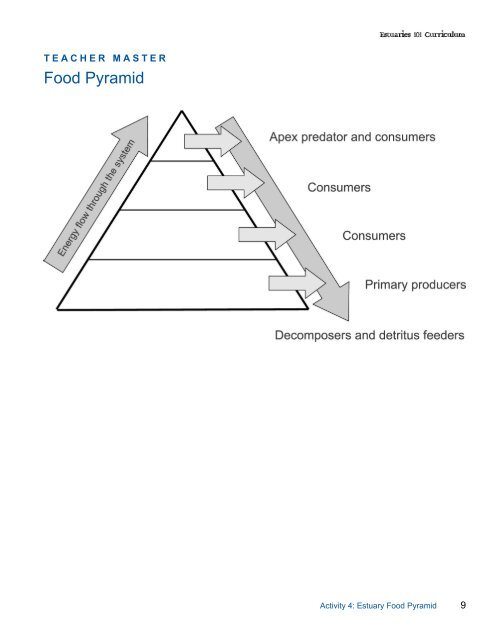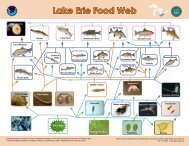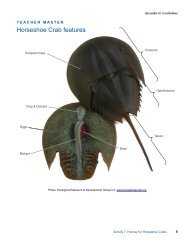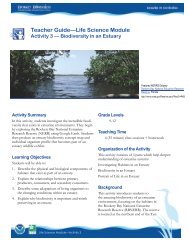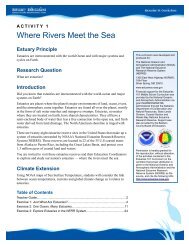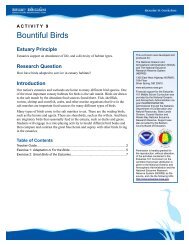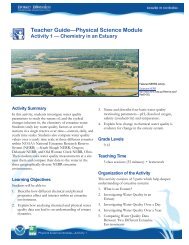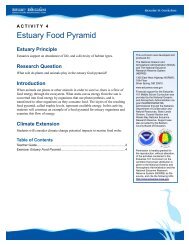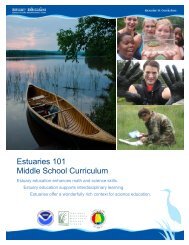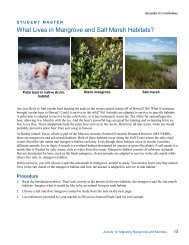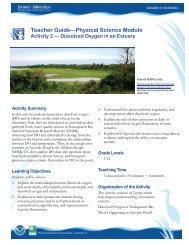You also want an ePaper? Increase the reach of your titles
YUMPU automatically turns print PDFs into web optimized ePapers that Google loves.
T E A C H E R M A S T E R<strong>Food</strong> <strong>Pyramid</strong>Activity 4: Estuary <strong>Food</strong> <strong>Pyramid</strong> 9
S T U D E N T M A S T E REstuary <strong>Food</strong> <strong>Pyramid</strong>When animals eat plants or other animals in order to survive, there is a flow of food energy through the ecosystem.What starts out as energy from the sun becomes food energy created by the green plants that use photosynthesis togrow and reproduce. These plants are the producers and the base of food chains and complex food webs.As one thing eats another, the layers of the food pyramid narrow. These layers, called trophic levels, representavailable energy. Animals at each trophic level depend on animals living in the levels below them for food energy. Thelargest amount of available food energy is found on the first trophic level, the base of the pyramid. Less than 10% ofthe amount of food energy that is available in one level is available to the animals in the trophic level just above. Thatmeans each higher level can support fewer and fewer organisms.Procedure1. Your teacher will assign you one of the organisms found on the Student Master: Estuary <strong>Food</strong> <strong>Pyramid</strong>Organisms. Read the description of your assigned organism.2. Draw a picture of your assigned organism on the food pyramid at the trophic level where you think it exists and/orfeeds. Write your organism’s name beneath your drawing.3. Now read the descriptions of the other four organisms on the Student Master: Estuary <strong>Food</strong> <strong>Pyramid</strong> Organisms.Based on the descriptions, draw and label an organism that exists on the trophic level just above your assignedorganism and an organism that exists on the trophic level just below your assigned organism. (Of course, this is nolevel above if your assigned organism is an apex predator. And there’s no level below if the organism is theproducer, except the decomposers and detritus feeders!)4. Next, use the computer to use the Interactive <strong>Food</strong> <strong>Pyramid</strong> simulation. You will find it in on the web page for thisactivity in the Middle School Curriculum section of the Estuary Education website at estuaries.noaa.gov.Duplicate your food pyramid from this Student Master by dragging the onscreen image of your assigned organismto its proper trophic level. Drag to add the organisms you have selected for the adjacent trophic levels. Now fill inother trophic levels with other available organisms in the simulation. Click the Check button to check your workas you add organisms to see the food web.5. Answer the questions on the next page.Activity 4: Estuary <strong>Food</strong> <strong>Pyramid</strong> 10
QuestionsQ1. Is your assigned organism a producer or a consumer? Explain.Q2. Where does your organism get its energy?Q3. Do you think there are many or few organisms located in your assigned organism’s trophic level?Why or why not?Q4. Write a paragraph describing the roles different organisms play in the estuary food pyramid.Activity 4: Estuary <strong>Food</strong> <strong>Pyramid</strong> 11
C L I M A T E E X T E N S I O NEstuary <strong>Food</strong> Webs and Climate ChangeIn this activity extension you will consider ways that the estuary food web could be impacted by climate change.Procedure1. Add the following organisms at the correct trophic level on your Estuary <strong>Food</strong> <strong>Pyramid</strong>: clam worm, raccoon,mussel, Bald Eagle, striped bass, blue crab, shrimp, and diamondback terrapin.2. Create a food web with the organisms on your Estuary <strong>Food</strong> <strong>Pyramid</strong> by drawing arrows that start at the anorganism being eaten to the organism that is doing the eating. Next use your completed estuary food web answerthe following question:Q5. How many organisms in your estuary food web rely directly on phytoplankton as a food source?Q6. How many organisms in your estuary food web rely indirectly on phytoplankton?3. Read the document titled “Marine Plankton <strong>Food</strong> Webs and Climate Change” and answer the following questions:Q7. List three environmental variables, associated with climate change, that are expected to have impacts onplankton.Q8. How could climate change cause an increase in some jellyfish populations and what impact would theincrease have on other organisms in a coastal food web?Q9. Why is it important for scientists to continue to study the impacts of climate change on estuarine and coastalplankton?Activity 4: Estuary <strong>Food</strong> <strong>Pyramid</strong> 13


